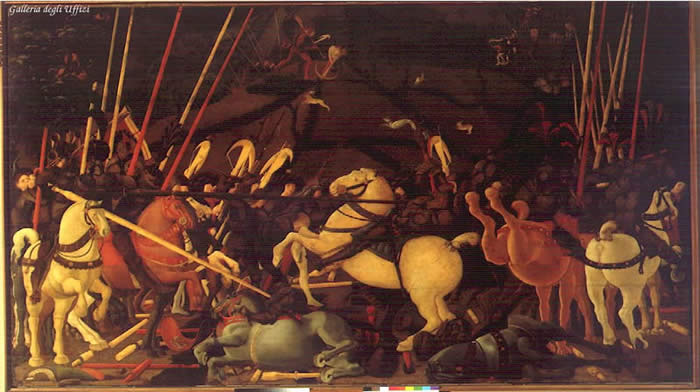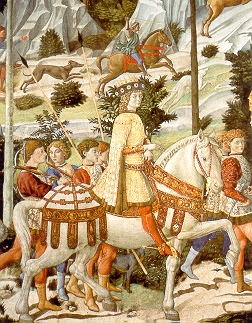Article first appeared on Baraka Book issue 7 - Autumn/Winter 1997
SIGHTHOUNDS AND ICONOLOGY
Roberto Forsoni
Iconology is the study of the cultural content of a work of art, through the interpretation of the meaning proper to each represented subject. Such subjects become the expression of the historical, social, philosophical and religious context which has produced them. We could also defìne it as a means of "reading" the artistic thought, going further beyond an analytic and descriptive analysis.
Even if it is general in its traits it is in fact considered as "history" and on the whole it could be very interesting to deepen our research about the meaning of each attribute of the picture in order to know and understand how in the flowing of time, sometimes even in the same period, the same attribute has been inserted in different images and above all with different characteristics.
Through an easy "reading" of three works of art which have a sighthound as a common feature of the represented history, we could point out the different meanings borne by such a common element.
The fìrst is the amazing "tondo" representing the Adorazione dei Magi (The three Wise Kings worshipping), a Domenico Veneziano's juvenile work (ante 1438) which after having been considered lost during the Second World War, is now kept in Berlin's Staatliche Museum.
The second is a painting, "La Battaglia di San Romano" (St. Roman's Fight) Paolo Uccello realized between 1456 and 1460 for the Medici family who commissioned it for a sitting room on the fìrst floor of their Palazzo and which is now preserved at the Uffizi in Florence. The third work we would like talk of is the large fresco Benozzo Gozzoli painted in 1459 in the private chapel of Palazzo Medici in Florence, where the traditional theme of the worshipping of the three Wise Kings becomes the realization of the cortege of princes which in 1439 had crossed the streets of Florence.
All the three works belong to the XV century and are linked to Florence and more precisely to the most famous Family of Florence who animated both the political and the cultural life of the town: the Medici.
For the two of them, namely Domenico Veneziano's "tondo" and Benozzo Gozzoli's fresco, the represented subjects are easy to recognize: the coming and worshipping of the three Wise Kings, whereas in Paolo Uccello's "tavola" we can recognize nothing but a battle with a hunting scene in the background. Moreover, the lack of drama in the battle on the foreground could give the painting itself the label of "corteous hydill" representing a knightly tournament and a hunting scene with swift sighthounds chasing the hares. The battle itself (St. Romano's battle) becomes the device exploited by the painter to represent the leisure time of the aristocracy when they are not involved in wars.
Hence nobility had two symbols to show its superiorità, i.e. the armed knight and the sighthound.
In Domenico Veneziano's work the couple of sighthounds on the proscenium bears a completely different meaning.
Not being involved in a hunting scene the sighthounds became the element which define the three Wise King's mother land: they are in fact an exotic factor which immediately recalls the Eastern Countries, as likewise the wonderful peacock painted on the top of the hunt does.
The theme of the three mighty kings bringing gifts to the new born Jesus will be largely exploited in Florence in the XV century. However, whereas in Veneziano's "tondo" the unfortunately unknown committant (perhaps a member of the Guicciardini Family of Florence as the picture probably comes from their household) remains confounded among the richly dressed characters following the three kings.
Piero de' Medici - Benozzo Gozzoli's committant - elaborates a well defined iconographic program intended to be the fittest celebration of his family. The fresco was meant to reproduce the cortege which in 1439 paraded along the streets in Florence to celebrate the Ecumenic Council for the reconciliation of the Eastern and the Western Churches. Likewise the three mighty eastern kings, the emperor John VIII Paleologus, Costantinople's Patriarch and the Pope Eugenio IV, were coming from faraway countries to a foreign town which is represented by the ancestor of the Medici Family: Cosimo de' Medici.
In Gozzoli's fresco, Piero de" Medici evokes that event having the two most powerful among the Kings represented likewise as the Emperor and of Costantinople's Patriarch and the youngest in those of Lorenzo de' Medici - Piero's son. Eugenio IV, the Pope, did not have the people's respect in those days since he had denied his favour to the Medici Family. Piero had also had himself represented in the Fresco, his father Cosimo and the whole family together wich their most mighty allies. Sigismondo Pandolfo Malatesta and Francesco Sforza in a unique, sumptuous glorification of his Casato.
What is then the meaning of the three sighthounds painted behind the young king on horseback according to such an iconographic "reading" of the fresco? Are they an exotic feature or simply meant to celebrate the noble committants?
Starting from iconographic and iconologic studies it is clear that the representation of the sighthound in a work of art is to be regarded as a subject having its own meaning and not as a mere embellishment having the same weight of a "still life".

